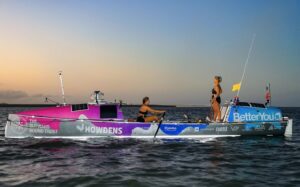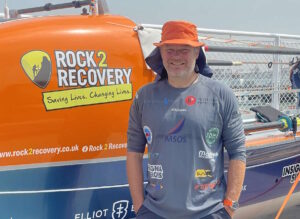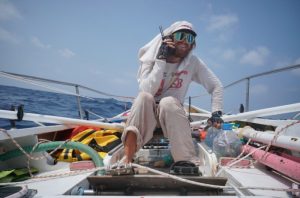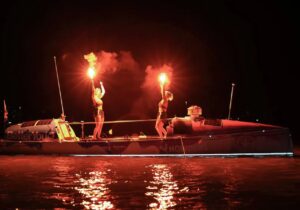Since our last ocean rowing roundup, two crews have finished their journeys, a world record has been set, and a fresh soloist is taking on the Atlantic.
Pacific Ocean
Ocean Revival: Matt Mason, Will Scott, Mike Donovan, and Stephen McHugh completed their crossing of the mid-Pacific from San Francisco to Hawaii on Aug. 6. They landed in Honolulu after 46 days and 21 hours at sea.
Unlike many other crews, they have not been battling strong winds. Instead, it has been incredibly calm water with strong currents. At points, this has brought them to a standstill. Other issues include struggling in the heat, a lip infection, blisters, and painful salt wounds. But despite these few ailments they have stayed incredibly positive. During calm periods they found their own fun: decorating the boat for Scott’s 40th birthday, holding diving competitions, and discussing their first meals back on dry land.
The final week of the row was eventful. A battery was leaking and a set of headphones caught fire, something they only noticed when they could suddenly smell smoke. Meanwhile, Scott’s lip infection remained open and bleeding, necessitating a second course of antibiotics.
Finally, they had to battle prevailing winds to land the boat.
Atlantic Ocean
Tom Waddington: Waddington (UK) is attempting to cross the North Atlantic from Canada to the UK. One of two soloists currently crossing this stretch of ocean, he was aiming to beat the 39-day record. Now 41 days in and just over halfway, he has missed his target by a considerable margin.
Completely new to ocean rowing, Waddington has struggled with patches of tricky weather. When he reached the Flemish Cap, the winds were against him and he was suddenly covering 25% or less of his normal distance. For five days, he needed to stay on para-anchor between rowing sessions to control how much he would drift.
Once he made it off the continental shelf, conditions improved. But bouts of good weather were short-lived. Twenty-four hours of good weather would be followed by twenty-four hours of changing winds.
A big part of his row has been accepting that he cannot beat the ocean. This required reframing each situation to stay upbeat. One thing that did cheer up Waddington was a passing ship. It was the first vessel he’d seen in weeks, and he rang them on his radio to chat with the captain.
He reached the halfway point on July 28, a huge moment after days of intense gales and storms. He hopes the second half of his journey will be shorter than the first, but it has been a bumpy start. In early August, Waddington capsized twice in two days. He lost his EPIRB and water containers, and the accidents damaged aerials and electronics. Fortunately, he has made repairs and had spares of everything lost at sea.
A few days later, his Automatic Identification System (AIS) signaled that a large vessel was nearby. They were on course to collide. Waddington radioed the boat to check they had seen him and could maneuver around him. Anxiously, he waited for a reply. After a long wait, he was getting ready to dig out a parachute flare when they eventually responded.
Patrick Favre: Favre (FR) is rowing across the North Atlantic from Canada to France. After waiting three weeks for a suitable weather window, he started in Saint Pierre and Miquelon on July 22. According to the Ocean Rowing Society, he has covered 54% of his route so far.
The experienced rower has made 22 successful solo ocean crossings and is also trying to best the 39-day record for this crossing. Favre is on track; he reached the halfway point in 17 days.
The first section saw Favre pick his way across the southeastern tip of Newfoundland to get to the open ocean. After three days, he made a safety stop at Trespassey Harbour. Unfavorable winds and heavy fog meant rowing would be too dangerous for a few days. It was so foggy that when he landed he could not see land, only the end of the pontoon.
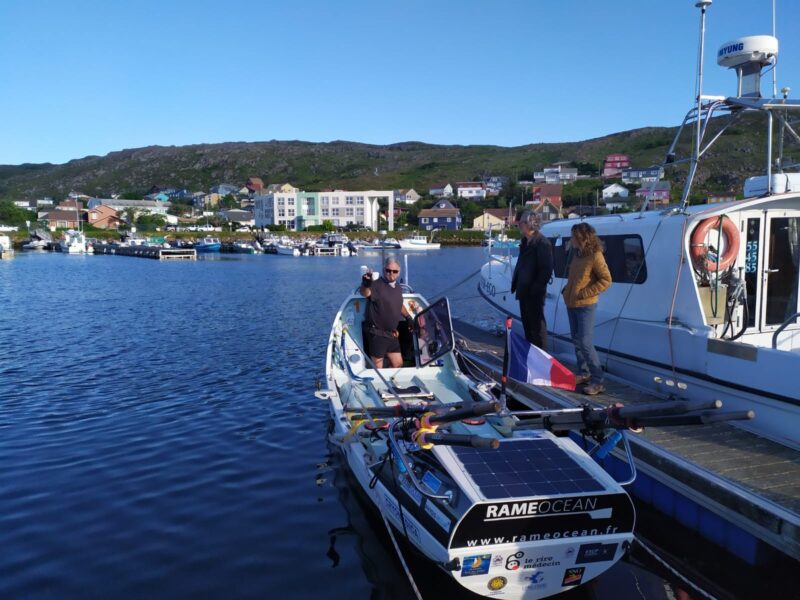
Photo: Rame Ocean
The winds died down after two days but the mist did not clear. Nevertheless, Favre decided he had waited long enough. First, he had to round Newfoundland’s Cape Race. Though technically in open ocean, Favre was still very close to land and needed to navigate maritime traffic. This meant constant vigilance, which can be exhausting during a solo crossing. At one point he had to dodge a nearby cargo ship, throwing the boat into crosswinds and big waves.
Visibility was poor and with everything on the boat relying on solar panels he tried to conserve electricity by only keeping essential pieces of kit on. Despite this, by Aug. 7 he had no power and was hit by force 7 winds. Favre sat on anchor again, waiting for the winds to die down and his solar panels to charge up the essentials.
Around the UK
GB Row Challenge: This challenge sees crews race clockwise around mainland Britain. On June 9, two boats set out from Tower Bridge, London. Sea Change pulled out after two weeks when high winds damaged their boat.
The only remaining crew, Coastal Odyssey, soldiered on and made it back to Tower Bridge on July 28. They set a new speed record for a mixed, six-person, unsupported row around Great Britain.

Photo: GB Row Challenge
A particularly tricky section of the route is the Pentland Firth, a 13km stretch of water between Orkney Island and the Scottish mainland. It has some of the fastest tidal currents in the world, and crews must wait for suitable weather. When their weather vane was almost completely still, at first the crew thought it must be broken. They had stumbled across unusually calm conditions and sped across the Firth before anything changed.
Though they had the odd day of slightly stronger winds, the rest of the row passed without any real issues.
The Long Row Home: Mhairi Ross and Allan Lipp (UK) are circumnavigating mainland Britain. After 75 days they are nearing the end of their journey. All that is left is to cross the top of Scotland and navigate the east coast to their hometown of Wick (their start and end point). They wanted to complete the 3,706km journey in 60 days but adverse weather made that impossible.
Over the last month, they rowed up the west coast of the UK and were thrilled to reach the halfway point at the end of July. They experienced “great” British weather for the duration, switching between wind, fog, pouring rain, and blistering heat. At times, winds and tides were so strong they were covering just 20km in 12 hours. At others, it was so still they barely moved.
One of the hardest sections came on days 61 and 62 when the pair tried to cross Saint George’s Channel.
“The planned 45nm passage ended up being much longer. A full tide cycle longer than planned,” they wrote on social media.
Northwest Passage
NWP Expedition: This team is finishing the journey they started in 2023. A full traverse of the Northwest Passage. Last year, they rowed the first 2,600km of the route before stopping because of the weather.
This year, they returned to Cambridge Bay to complete the final (and easiest) 1,100km to Point Burrow in Alaska. They set off on Aug. 2. On just the second day on the water, Stefan Hacker realized three of the ration packs he had eaten had gone bad. This did not bode well for the third day.
“The following day I would see myself overdosing on immodium and sitting on the bucket,” he wrote in a blog post.
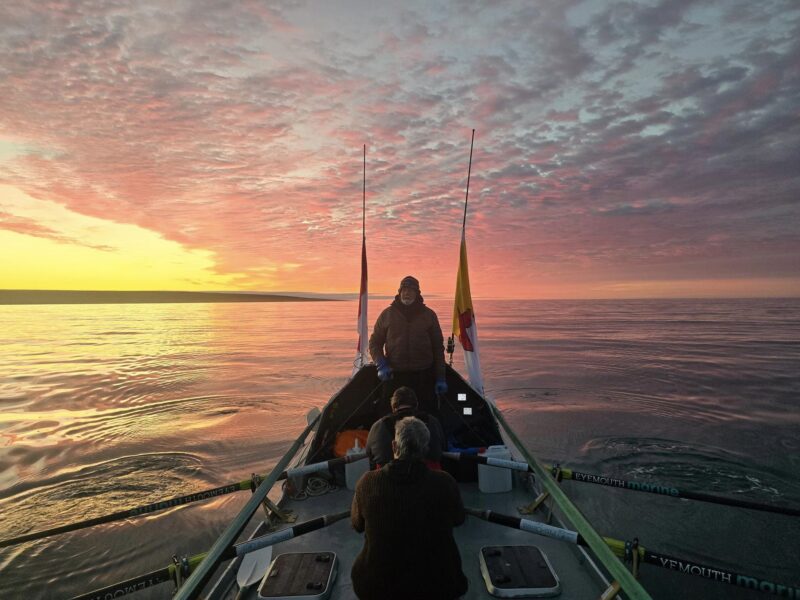
Photo: NWP Expedition
Rotten rations aside, the first two weeks have been slow and difficult. After crossing Wellington Bay, high winds trapped the team. They spent days waiting on the western shore for conditions to change.
Finally able to move on, they have been struggling to build up a head of steam. They are rowing during calm patches and then anchoring to wait out headwinds. They are currently approaching Coronation Gulf.


